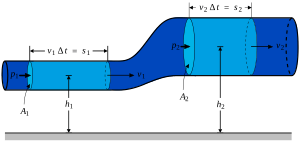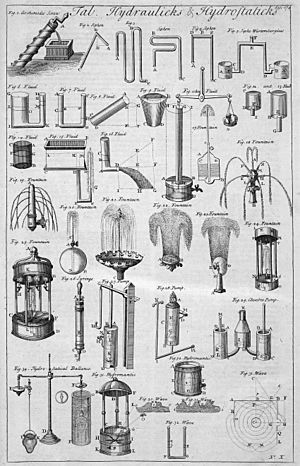Hydrostatics facts for kids
| Mechanics | ||||||||||

|
||||||||||
Fluid statics (also called hydrostatics) is a part of fluid mechanics. It studies how fluids (like liquids and gases) behave when they are completely still or "at rest." It also looks at the pressure these fluids create on objects placed in them.
Think of it as understanding why things float, why water stays level in a glass, or why the air pressure changes as you go higher up a mountain. It's different from fluid dynamics, which studies fluids that are moving.
Hydrostatics is super important for many things we use every day. It's key to hydraulics, which is about designing systems that use fluids, like the brakes in a car or the machines that lift heavy objects. It also helps scientists understand plate tectonics (how Earth's crust moves), weather patterns, and even blood pressure in our bodies.
This field helps explain common things, like why wood floats on water, or why the surface of calm water is always flat, no matter what shape its container is.
Contents
History of Hydrostatics
People have known some basic ideas about hydrostatics for a very long time. Ancient builders of boats, water tanks, and aqueducts used these ideas without even knowing the scientific terms.
Archimedes and Buoyancy
The famous Greek thinker Archimedes is known for discovering Archimedes' Principle. This principle explains that when an object is placed in a fluid, the fluid pushes up on it with a force called buoyancy. This upward push is equal to the weight of the fluid that the object moves out of the way. This is why boats float!
The Roman engineer Vitruvius also knew about hydrostatic pressure. He warned that lead pipes could burst if the water pressure inside them became too high.
Pascal's Ideas on Pressure
Later, in 1647, the French mathematician and philosopher Blaise Pascal developed the idea of pressure and how fluids spread it around.
Pythagorean Cup
The "fair cup" or Pythagorean cup is an old invention, possibly from the 6th century BC, credited to the Greek mathematician Pythagoras. It was used to teach about water levels.
This cup has a line carved inside it and a small pipe in the center that goes down to the bottom. You can fill the cup up to the line without any water going into the pipe. But if you pour in just a little bit more water, it overflows into the pipe. Because of how water molecules pull on each other, the entire cup then empties out through the bottom!
Heron's Fountain
Heron's fountain was invented by Heron of Alexandria. It's a clever device that makes a jet of water shoot up higher than the water level in its main tank. This might seem like magic, but it uses trapped air to push the water.
The fountain has an opening and two containers, one above the other. The middle container is sealed and filled with water. Several small tubes connect the containers. Air trapped inside gets squeezed, which pushes water out of a nozzle, making a tall jet.
Pascal's Law
Blaise Pascal made important discoveries in hydrostatics. Pascal's Law is a key rule in fluid mechanics. It says that if you apply pressure to any part of a fluid that's enclosed (like water in a pipe), that pressure will spread equally throughout the entire fluid in all directions. This means the pressure won't change as it moves through the fluid.
Pressure in Still Fluids
Fluids that are not moving cannot have "shear stress." This is a force that tries to twist or deform something. However, still fluids can push straight out (normal) on any surface they touch. This push is called pressure.
Imagine a tiny cube of fluid. The pressure on every side of this tiny cube must be equal. If it wasn't, the fluid would start to move in the direction of the stronger push. This means that pressure in a still fluid is "isotropic," which means it's the same in all directions. This is why fluids can transmit force through pipes: a push at one end of a pipe filled with fluid is felt at the other end.
Hydrostatic Pressure
When a fluid is completely still, we call its state of pressure "hydrostatic." The pressure in a still fluid changes with depth because of gravity. The deeper you go, the more fluid is above you, pushing down.
You can figure out hydrostatic pressure with a simple formula: Pressure = Fluid Density × Gravitational Acceleration × Height
- Pressure (p) is how much force is spread over an area.
- Fluid Density (ρ) is how much "stuff" (mass) is packed into a certain space in the fluid. Water is denser than air, for example.
- Gravitational Acceleration (g) is the force that pulls things down, like on Earth.
- Height (h) is the depth of the fluid column above the point you're measuring.
So, the deeper you go into a liquid, the higher the pressure. This is why your ears might pop when you dive deep into a swimming pool!
For example, the total pressure at a certain depth in water is the pressure from the water itself plus the atmospheric pressure (the pressure from the air above the water).
Hydrostatic pressure is even used in food preservation, in a process called "pascalization," which uses high pressure to kill germs.
Hydrostatic Pressure in Medicine
In medicine, hydrostatic pressure in blood vessels is the pressure of the blood pushing against the walls of the vessels. This pressure is important for how blood flows through your body.
Atmospheric Pressure
The air around us is also a fluid, and it creates pressure too! This is called atmospheric pressure. It changes with height. The higher you go (like up a mountain), the less air is above you, so the atmospheric pressure decreases. This is why it's harder to breathe at very high altitudes.
Buoyancy
When an object is placed in a fluid, the fluid pushes up on it. This upward push is called buoyancy or buoyant force. It's the reason why things float!
The buoyant force is equal to the weight of the fluid that the object pushes out of the way. So, if a ship weighs a lot, it needs to push aside a lot of water to float. If you load more cargo onto a ship, it sinks a bit deeper, pushing aside more water until the buoyant force is strong enough to balance the new, heavier weight.
This principle was discovered by Archimedes.
Liquids with Free Surfaces
Liquids often have a "free surface," which is where they meet air or empty space. Because liquids can't hold their shape like solids, their surfaces quickly become flat and level when they are still. However, on very small scales, another force called surface tension becomes important.
Capillary Action
When liquids are in very narrow tubes or spaces, surface tension can cause them to behave in interesting ways. This is called capillary action. For example, water can climb up the inside of a very thin glass tube, forming a curved surface called a meniscus.
Capillary action is super important in nature! It's one of the main ways that water moves up from the roots to the leaves in plants.
Hanging Drops
Without surface tension, liquid drops wouldn't be able to form. Surface tension is what holds a drop together and gives it its shape. The stronger the surface tension, the more "sticky" the liquid molecules are to each other, and the more stable the drops will be.
See also
 In Spanish: Hidrostática para niños
In Spanish: Hidrostática para niños
- Communicating vessels
- Hydrostatic test
- D-DIA


